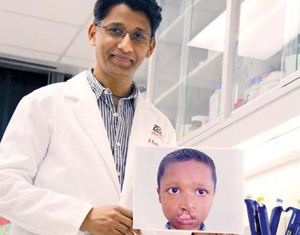Until the flood of 1988, few had paid attention to cleft lip and palate in the rural hillsides of Bangladesh.
That changed when Ali Nawshad, D.D.S., Ph.D., arrived to help with relief efforts. The young dental student was struck by the number of children he saw with the deformity.
Suddenly, his plans to practice dentistry seemed insignificant.
 |
Ali Nawshad, D.D.S., Ph.D. |
Twenty years after that fateful flood, he received a $1.8 million grant from the National Institutes of Health to continue his work to eliminate cleft palate in fetuses.
Cleft lip and palate occurs when the palatal shelves in the roof of the mouth fail to grow and fuse.
It is not lifethreatening but it does disrupt feeding, digestion, speech, hearing and respiration.
It also can lead to emotional, psychological, social and learning problems and is an economic burden amounting to $1 billion in health care costs annually in the United States, according to a 2006 report from the Centers for Disease Control and Prevention.
Dr. Nawshad has spent the past decade studying — first at Harvard Medical School with renowned embryologist Elizabeth Hay and now at UNMC — how to fix cleft palate in children before they are born.
|
“If you knock out this gene in mice, they are always born with cleft lip and palate and no other deformity,” Dr. Nawshad said. He also learned there are lesser, but just as important, genes essential for normal palate development.
“Our goal is to reintroduce those genes into the pups of pregnant mice to determine if the deformity can be corrected in the womb,” Dr. Nawshad said.
While the rates of cleft lip and palate are still high in Bangladesh, he said, the highest incidence is among American Indians, as well as the indigenous people of South America.
The lowest incidence rates are in African-Americans.
“As we better understand the basic science of cleft palate, we can improve the lives of children around the world,” Dr. Nawshad said.